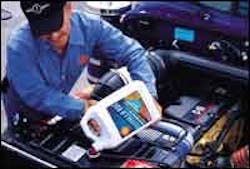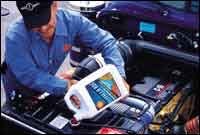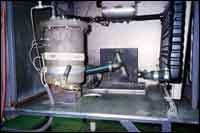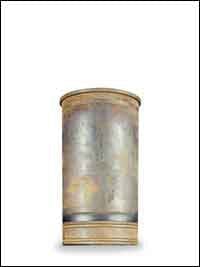Any Idea What's in Your Radiator?
No matter what you might believe about new heavy-duty antifreeze formulations, virtually all antifreeze is roughly 95 percent ethylene glycol and 5 percent water and additives. The stuff that isn't made from ethylene glycol (only about 1 percent of all antifreeze sold) is made from propylene glycol, which is less toxic, but also more expensive than ethylene glycol. Coolant is created when antifreeze is mixed with 40 to 60 percent water. This all sounds straightforward enough, but swirling around that 5-percent additive content is lots of discussion—dare we say confusion.
The additive (or inhibitor) package blended into ethylene glycol is required to help fight rust, scale and corrosion in heavy-duty cooling systems. And in diesel-engine cooling systems, of course, additives also must fight wet-sleeve cavitation, the erosion of cylinder sleeves—potentially creating holes into the combustion chamber-caused by air bubbles in the coolant imploding with great force against the sleeves.
Different types of antifreeze, though, use different additive formulations to fight these cooling-system killers. Because the chemical fingerprint of additive packages can differ substantially between antifreeze types, equipment owners may be left wondering what to buy and what happens if different technologies are mixed. And, of course, the prospect of mixing antifreeze types is ever present, because the cooling systems in most big trucks and earthmoving machines leak, and radiators are continually being topped off. Even in small fleets, coolant leakage can mean purchasing a sizeable volume of replacement antifreeze.
So, if you need help sorting through the broad range of products available, a good starting point may be a quick review of basic antifreeze types. But be forewarned, opinions differ about how best to do this. To begin, however, let's use the classifications of conventional, organic-acid, and hybrid.
Until 10 or 12 years ago, heavy-duty engines were filled with conventional antifreeze, identified by the American Society for Testing and Materials (ASTM) standard D-4985, as a "heavy-duty, low-silicate" type. This antifreeze, however, which is still in prevalent use today and is usually dyed green, can't be used in diesel engines without first treating (or "precharging") it with an inhibitor package, often called a "supplemental coolant additive" (SCA). The required initial treatment is an approximate 3-percent concentration of SCA (one pint per four gallons of cooling-system capacity).
Today, however, the preferred conventional antifreeze for diesel engines or mixed fleets is fully formulated, identified as ASTM D-6210 or RP-329 by the Technology & Maintenance Council (TMC). This antifreeze often is pink, but also can be green or blue. Fully formulated conventional antifreeze is standard factory fill for all U.S. heavy truck makers, except for International and GM's medium-duty Kodiak and TopKick, which use an organic-acid type. Most truck makers, however, offer organic-acid or hybrid-type antifreezes as options.
Fully formulated conventional antifreeze is a blend of ethylene glycol and an inhibitor package typically containing nitrate to protect iron and steel, tolyltriazole to protect copper and brass, borate or phosphate to buffer acids (formed as glycol breaks down) and silicate to protect aluminum. A key ingredient in the package is nitrite (sometimes accompanied by molybdate) that forms a cavitation-resistant barrier on wet sleeves. Some of these inhibitors deplete as the coolant works; however, nitrite, in particular, must be replenished periodically with an SCA.
Dean Swick, national sales manager for Penray, a company that makes additives for antifreeze manufacturers, suggests that the buyer carefully evaluate conventional-antifreeze choices. A good fully formulated conventional product, he says, is about the same price as a typical low-grade conventional with the SCA added. Get the SCA concentration wrong, says Swick, and you may go through a set of sleeves. Plus, he says, the factory-made fully formulated antifreeze probably has a more balanced overall additive content that prolongs water-pump life.
To simplify coolant maintenance, the antifreeze industry next developed "extended-life" products, typically with an advertised longevity of 600,000 miles or 12,000 hours. These formulations, originally at least, replaced the inhibitor package used in fully formulated conventional antifreeze with "organic-acid" inhibitors, designed to help metal parts form a protective skin against destructive forces in the coolant. These products most often are called "organic-acid-technology" (OAT) antifreezes, because they use the base or neutralized version of organic (carbon-containing) acids.
Some experts, though, such as Ed Eaton, chief chemist for Amalgatech, a coolant-evaluation and R & D laboratory in Phoenix, Ariz., prefer the term "carboxylate" or "carboxylate-inhibited" for these extended-life products. The term "organic acid" is too broad, says Eaton, while "carboxylate" is more specific and typically refers to antifreezes characterized by the use of two chemicals, 2-ethyl hexanoic acid (2-EH) and/or sebacic acid. In the heavy-duty market, says Eaton, these antifreezes usually are red in color and include Shell Rotella ELC (Extended Life Coolant), Caterpillar ELC and Texaco ELC.
According to Eaton, most heavy-duty carboxylate formulations also contain some of the "inorganic" inhibitors contained in fully formulated conventional antifreeze, namely nitrite and molybdate as secondary inhibitors. Some formulations also may include silicate. Those that include nitrite sometimes are called NOAT formulations, for "nitrited-organic-acid-technology" antifreeze.
Unlike fully formulated conventional antifreeze, however, which requires relatively frequent additions of SCA to replenish the nitrite concentration, most NOAT formulations require the addition of an "extender" only at 300,000 miles or 6,000 hours. According to Shell's recommendations for maintaining Rotella ELC, the extender replenishes nitrite and is used in quantities from ½ quart to 2 gallons, depending on cooling-system capacity. Shell notes, however, that most European engine manufacturers "do not require nitrite when an extended life coolant like Rotella ELC is used."
All of this begs the question, then, about whether antifreezes using organic-acid technology alone, as originally designed, have the capability to adequately protect a diesel's cooling system? Says Eaton, "there is persuasive evidence that they do." Carboxylates, he says, change the surface tension of water, potentially providing more efficient cooling (through better wetting of surfaces) and cavitation protection (because coolant bubbles either don't form or they're softer and don't attack the sleeves). But, he says, the latter theory is a matter of some debate.
According to chemist Frank Cook, Ph.D., senior vice president of Old World Industries, a leading antifreeze manufacturer, anytime you add any inorganic inhibitors (typically used in fully formulated conventional antifreeze) to an organic-acid-based antifreeze, you have created a hybrid or a Hybrid OAT or simply a HOAT. Much of the industry agrees, although some are of the opinion that a nitrite-containing OAT is not a hybrid. Eaton, again, is more specific in his definition, saying that a hybrid is a product characterized by the use of benzoate, from benzoic acid, another organic acid.
Under Eaton's definition, products such as Old World's Final Charge, Detroit Diesel's Power Cool Plus and Fleetguard's ESXtreme are hybrids. No, says Cook, Old World's Final Charge is best described as a true organic-acid antifreeze (but not based on 2-EH technology), because it contains no inorganic inhibitors, which many of the world's engine makers dislike.
The jury is still officially out on the issue of antifreeze-type compatibility, but some have suspicions.
In Eaton's opinion, carboxylate and conventional antifreezes do not mix well. A carboxylate (with organic-acid technology) operates at a pH level of 6.5 to 8.5, he says, while a conventional likes a pH of 8.5 to 10.5. (The pH scale measures acidity or alkalinity and ranges from 0-14. Neutral is 7, and the higher the number, the more alkaline.) This is important, says Eaton, because the solubility limits for silicate and phosphate in conventional antifreeze are dependent on pH. Pour an OAT into a fully formulated conventional, he says, and pH can fall and cause the silicate can drop out.
"This does not necessarily create a corrosion problem," says Eaton, "but now you have solids floating around."
Shell cautions users of Rotella ELC not to add "non-equivalent" antifreeze and offers a test strip to measure carboxylate levels on a pass/fail basis. Rotella ELC diluted with more than 15 percent conventional antifreeze, says Shell, may have insufficient inhibitor levels. In this instance, the user can drain and refill the system with the original product, or begin treating the coolant as conventional antifreeze, adding SCA and topping off with fully formulated conventional.
Successfully converting to a fully formulated conventional system, though, assumes that the contaminated carboxylate is not too old, says Howard Laga, vice president of sales and marketing for Penray. If not, the freeze point should be adjusted with a fully formulated conventional product, and the system immediately treated to an approximate 3-percent SCA concentration. Then, he says, the coolant can be maintained as a fully formulated conventional system, analyzing it periodically with a test strip to test freeze point and nitrite (or nitrite/molybdate) levels, then adding SCA when required.
According to Old World's Cook, however, the company's new Final Charge antifreeze contains patented "contamination tolerant additives," CTAs, that allow it to be mixed in any proportion with other organic-acid or conventional antifreezes, or with hard water, "with no detrimental effects to corrosion protection."
Other organic-acid technologies can be converted to Final Charge, says Cook, by simply topping off with the new product. Fully formulated conventional systems can be changed over, he says, by adding an initial "converter" fluid, then topping off from then on with Final Charge.
Fully formulated conventional antifreeze can be maintained with liquid SCA or with SCA contained in a filter. Two major types of SCA are available, those with a nitrite/borate formulation, as represented by Penray, and those with a nitrite/molybdate/phosphate formulation, as represented by Fleetguard. It's best not to mix them, but most experts agree that no serious consequences result if they are mixed. You should, however, try to use a test strip that's designed for the particular formulation. (Test strips are chemically sensitive paper that changes colors to indicate freeze-point protection and the nitrite (molybdate) concentration.)
But, what you definitely don't want to do is buy inferior-quality SCA, those that contain some level of nitrite (or nitrite-molybdate), but little else. Although not universally true, if an SCA has a bargain price, it's probably no bargain. Look for an ASTM standard, likely D-5752, on the SCA package.
And, don't buy into the philosophy that extended-life coolant needs no maintenance. Inspect it at every regular maintenance interval to make sure that it's clear (no rust), that the color is right and that it has sufficient freeze protection (using a refractometer). Some question whether a test strip for fully formulated conventional antifreeze can be used to check for nitrite if it's contained in an extended-life product. Most experts say probably not.
Overall, says Eaton, most of the various antifreezes on the market today are excellent products. He says you're best off, though, if you pick an antifreeze type, and then stick with it, taking all the safeguards practical to avoid mixing it with other types. This implies also that you pick the maintenance strategy recommended for the antifreeze chosen and, again, stick with it.




